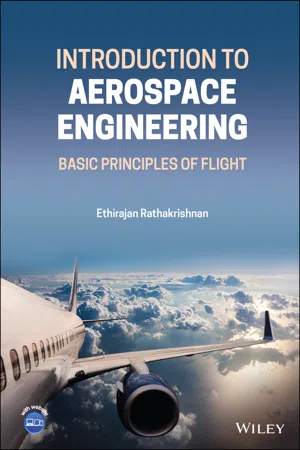
- English
- ePUB (mobile friendly)
- Available on iOS & Android
About this book
Provides a broad and accessible introduction to the field of aerospace engineering, ideal for semester-long courses
Aerospace engineering, the field of engineering focused on the development of aircraft and spacecraft, is taught at universities in both dedicated aerospace engineering programs as well as in wider mechanical engineering curriculums around the world-yet accessible introductory textbooks covering all essential areas of the subject are rare. Filling this significant gap in the market, Introduction to Aerospace Engineering: Basic Principles of Flight provides beginning students with a strong foundational knowledge of the key concepts they will further explore as they advance through their studies.
Designed to align with the curriculum of a single-semester course, this comprehensive textbook offers a student-friendly presentation that combines the theoretical and practical aspects of aerospace engineering. Clear and concise chapters cover the laws of aerodynamics, pressure, and atmospheric modeling, aircraft configurations, the forces of flight, stability and control, rockets, propulsion, and more. Detailed illustrations, well-defined equations, end-of-chapter summaries, and ample review questions throughout the text ensure students understand the core topics of aerodynamics, propulsion, flight mechanics, and aircraft performance. Drawn from the author's thirty years' experience teaching the subject to countless numbers of university students, this much-needed textbook:
- Explains basic vocabulary and fundamental aerodynamic concepts
- Describes aircraft configurations, low-speed aerofoils, high-lift devices, and rockets
- Covers essential topics including thrust, propulsion, performance, maneuvers, and stability and control
- Introduces each topic in a concise and straightforward manner as students are guided through progressively more advanced material
- Includes access to companion website containing a solutions manual and lecture slides for instructors
Introduction to Aerospace Engineering: Basic Principles of Flight is the perfect "one stop" textbook for instructors, undergraduates, and graduate students in Introduction to Aerospace Engineering or Introduction to Flight courses in Aerospace Engineering or Mechanical Engineering programs.
Frequently asked questions
- Essential is ideal for learners and professionals who enjoy exploring a wide range of subjects. Access the Essential Library with 800,000+ trusted titles and best-sellers across business, personal growth, and the humanities. Includes unlimited reading time and Standard Read Aloud voice.
- Complete: Perfect for advanced learners and researchers needing full, unrestricted access. Unlock 1.4M+ books across hundreds of subjects, including academic and specialized titles. The Complete Plan also includes advanced features like Premium Read Aloud and Research Assistant.
Please note we cannot support devices running on iOS 13 and Android 7 or earlier. Learn more about using the app.
Information
1
Basics
1.1 Introduction
1.2 Overview






1.3 Modern Era
Table of contents
- Cover
- Table of Contents
- Title Page
- Copyright
- Dedication
- Preface
- About the Author
- About the Companion Website
- 1 Basics
- 2 International Standard Atmosphere
- 3 Aircraft Configurations
- 4 Low‐Speed Aerofoils
- 5 High‐Lift Devices
- 6 Thrust
- 7 Level Flight
- 8 Gliding
- 9 Performance
- 10 Stability and Control
- 11 Manoeuvres
- 12 Rockets
- References
- Appendix A
- Index
- End User License Agreement